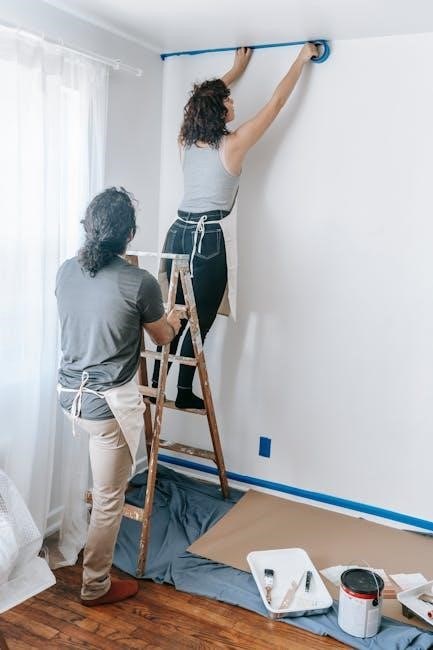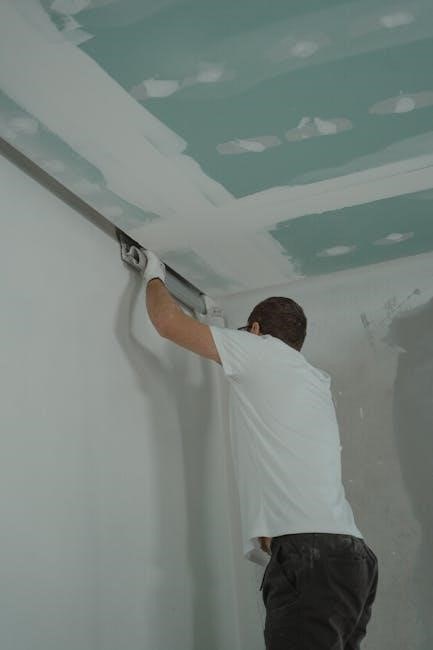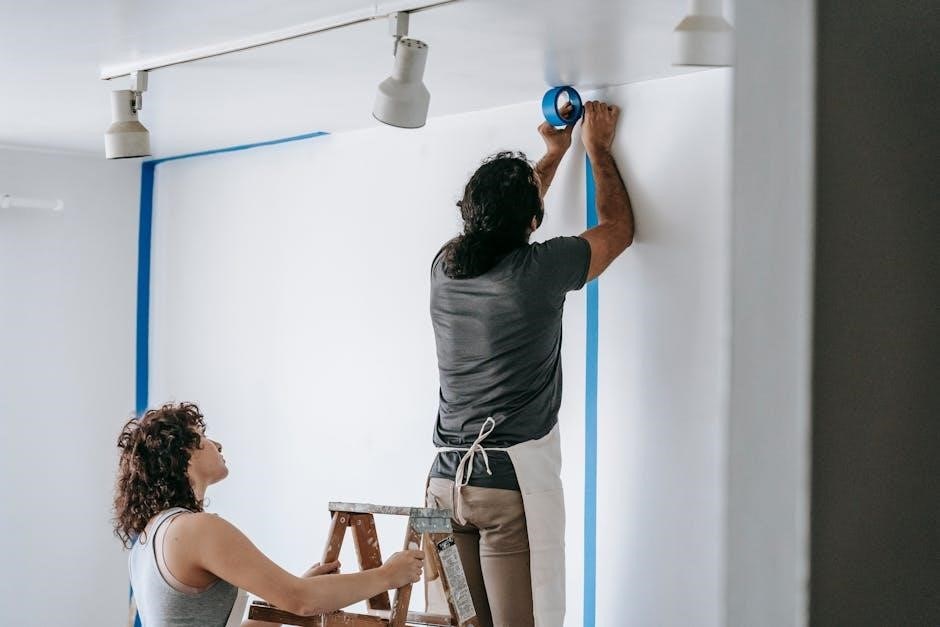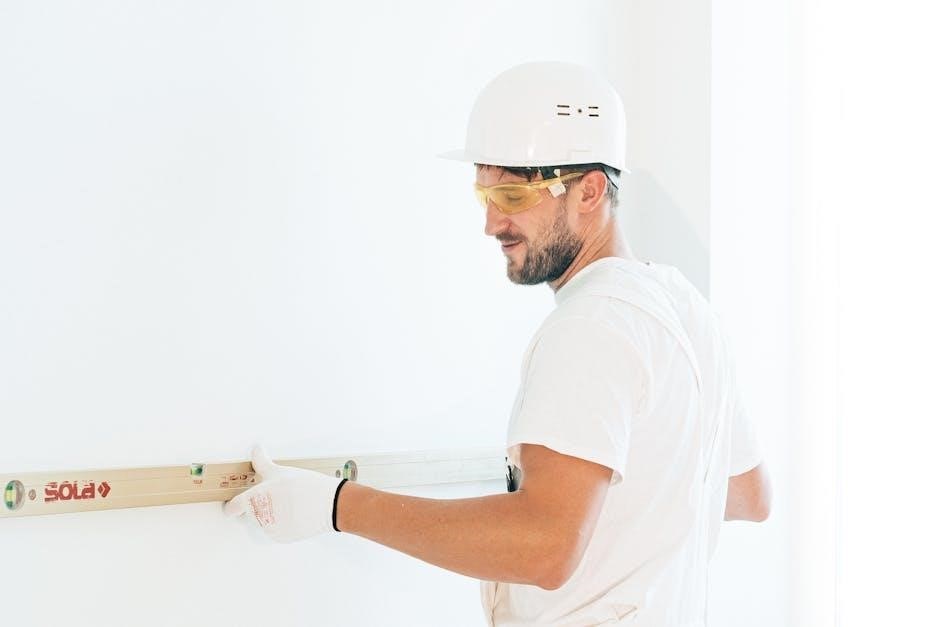
Discover the essentials of Belgard retaining wall installation‚ featuring innovative systems like Tandem Wall for versatile designs. This guide ensures structural integrity and aesthetic appeal‚ perfect for homeowners and contractors seeking durable‚ elegant outdoor solutions.
Overview of Belgard Retaining Walls
Belgard retaining walls are engineered to combine strength‚ durability‚ and aesthetic appeal‚ offering versatile solutions for outdoor spaces. Available in various styles‚ including gravity and reinforced systems‚ these walls are designed to withstand environmental stress while enhancing landscapes. The Tandem Wall system‚ for instance‚ allows for both straight and curved configurations‚ making it ideal for complex designs. Belgard blocks are crafted from high-quality materials‚ ensuring long-lasting performance and minimal maintenance. Whether for structural support or decorative purposes‚ Belgard retaining walls provide a reliable and visually appealing option for homeowners and contractors alike. Their innovative design ensures stability and timeless beauty.
Importance of Proper Installation Techniques
Proper installation techniques are crucial for ensuring the structural integrity and longevity of Belgard retaining walls. Incorrect methods can lead to instability‚ water damage‚ or even collapse. Using the right materials‚ such as concrete sand for bedding‚ and following precise leveling and compacting steps ensures a stable foundation. Proper drainage installation prevents water accumulation‚ which can undermine the wall. Adhering to manufacturer guidelines and best practices guarantees both safety and aesthetic appeal‚ making the wall durable and functional for years to come.

Understanding the Types of Belgard Retaining Walls
Belgard offers two primary types: gravity walls‚ relying on weight for stability‚ and reinforced walls‚ utilizing geogrids for added strength. Both provide design flexibility and durability for various structural needs.
Gravity Retaining Walls
A gravity retaining wall relies on its weight to hold back soil without soil reinforcement. It typically uses modular blocks‚ requiring two for each veneer unit. These walls are simple to construct and suitable for low-height applications. They depend on the mass of the blocks and proper base preparation to ensure stability. Concrete sand is recommended for bedding‚ while road base material is used for the base layer. Gravity walls are ideal for smaller projects‚ offering a cost-effective solution with aesthetic appeal. They are a popular choice for homeowners due to their ease of installation and versatility in design.
Reinforced Retaining Walls
Reinforced retaining walls utilize additional structural support‚ such as geogrids or steel reinforcement‚ to enhance stability and resist soil pressure. These systems are ideal for taller walls or unstable soil conditions. Unlike gravity walls‚ reinforced walls rely on engineered materials to distribute loads more effectively. They are constructed in layers‚ with each course securely connected to the next‚ ensuring long-term durability. Proper backfilling and drainage are critical to their performance. Reinforced walls are a reliable choice for challenging sites‚ offering both strength and design flexibility. Belgard’s systems provide innovative solutions for complex retaining wall projects‚ ensuring structural integrity and aesthetic appeal.

Planning and Preparation
Effective planning ensures a successful Belgard retaining wall project. Assess site conditions‚ select appropriate materials‚ obtain necessary permits‚ and design a detailed proper layout.
Assessing the Site Conditions
Evaluating the site is crucial for a successful Belgard retaining wall installation. Begin by analyzing the soil type‚ drainage patterns‚ and load-bearing capacity of the ground. Check for slopes or uneven terrain that may affect the wall’s stability. Ensure the area is clear of debris and vegetation. Measure the natural water flow to avoid drainage issues post-construction. Identifying these factors early helps in selecting the right materials and design‚ ensuring the wall withstands environmental pressures and remains structurally sound. Proper site assessment is the foundation of a durable and functional retaining wall system.
Choosing the Right Belgard Blocks for Your Project
Selecting the appropriate Belgard blocks is crucial for both functionality and design. Consider the load-bearing requirements‚ desired aesthetic‚ and site conditions. Belgard offers versatile options like Tandem Wall blocks‚ suitable for curved or straight designs. Ensure blocks align with your project’s structural needs‚ whether decorative or retaining. Proper material selection enhances durability and ensures a stable structure. Always consult Belgard’s resources or professionals to make an informed decision‚ guaranteeing your wall meets both functional and visual expectations.
Obtaining Necessary Permits and Approvals
Before starting your Belgard retaining wall project‚ ensure compliance with local building codes and regulations. Check zoning laws‚ as retaining walls may require permits‚ especially if they exceed certain heights or are near property lines. Submit detailed plans‚ including wall design‚ materials‚ and site layout‚ for approval. Inspection by local authorities may be necessary to verify structural integrity and safety standards. Failure to obtain proper permits can lead to legal issues or project delays. Always consult with your local government or a licensed professional to ensure full compliance and avoid potential penalties.
Planning the Wall Layout and Design
Planning the wall layout and design is crucial for a successful Belgard retaining wall installation. Begin by assessing the site conditions and intended use to determine the wall’s height‚ length‚ and curvature. Choose Belgard blocks that complement your landscape and meet structural requirements. Ensure compliance with local building codes and obtain necessary permits. Sketch a detailed design plan‚ considering drainage and aesthetics. Use graph paper or design software for precision. Refer to Belgard’s installation guides for specific block configurations and spacing. Proper planning ensures a visually appealing and structurally sound retaining wall that enhances your outdoor space.

Tools and Materials Required
Essential tools include excavators‚ compactors‚ and leveling tools. Materials needed are Belgard blocks‚ concrete sand‚ road base material‚ and paver edge restraints for stability and durability.
Essential Tools for Retaining Wall Installation
To ensure a successful installation‚ gather the necessary tools. A shovel is needed for excavation‚ while a level ensures the ground and blocks are properly aligned. A tamping tool or plate compactor is crucial for compacting the base material and sand layer. Measuring tools‚ such as a tape measure and square‚ help maintain accurate dimensions. A wheelbarrow or utility cart is handy for transporting materials. Safety gear‚ including gloves and safety glasses‚ is essential. For cutting blocks‚ a saw or masonry cutter is required. Edge restraints and geotextile fabric tools may also be needed for stability and drainage.
Materials Needed for Construction
The essential materials for constructing a Belgard retaining wall include Belgard modular blocks‚ road base material for the foundation‚ and concrete sand for leveling. Paver edge restraints are required to secure the wall edges‚ while drainage materials like geotextile fabric and aggregate ensure proper water management. Additional components may include capstones for finishing and sealants to protect the joints. Always use materials recommended by Belgard to ensure durability and structural integrity. Proper selection and preparation of these materials are crucial for a successful installation. Ensure all items are readily available before starting the project.
Site Preparation Steps
Site preparation involves excavation‚ clearing debris‚ leveling the ground‚ compacting base material‚ and installing a sand layer. Use concrete sand for optimal leveling and stability.
Excavation and Site Clearing
Begin by marking the area where the retaining wall will be built. Clear the site of debris‚ vegetation‚ and obstructions to ensure a clean work surface. Excavate the ground to the required depth‚ typically 12 inches for the base material and sand layer. Use a level to ensure the excavation is even and aligns with your wall design. Proper site preparation is crucial for stability‚ so take care to remove any uneven soil or rocks that could disrupt construction. This step sets the foundation for a secure and level retaining wall installation.
Leveling the Ground
Proper leveling is crucial for a stable Belgard retaining wall. Begin by laying a nominal 1-inch uncompacted bedding sand layer. Use concrete sand‚ as masonry sand or screenings are not suitable. Screed the sand to ensure an even surface; Check the ground with a spirit level or laser level to confirm it’s perfectly horizontal. Compact the sand lightly to prevent shifting during construction. This step ensures the first course of blocks will sit evenly‚ providing a solid foundation for the entire wall structure and maintaining its structural integrity over time.
Compacting the Base Material
Compacting the base material is a critical step in ensuring the stability of your Belgard retaining wall. Use a plate compactor or hand tamper to firmly compress the road base material‚ ensuring a solid foundation. Proper compaction prevents settling and shifting‚ which can lead to structural issues. Compact in layers‚ starting from the edges and working inward‚ to achieve uniform density. This step is essential for maintaining the wall’s integrity and longevity. Always follow manufacturer guidelines for the specific materials you’re using to ensure optimal results.
Installing the Sand Layer
A nominal 1-inch layer of uncompacted bedding sand is essential for a stable base. Use concrete sand‚ as masonry sand or screenings are not suitable. Spread the sand evenly across the compacted base‚ ensuring full coverage. Use a screed or leveling tool to achieve a smooth‚ level surface. Avoid over-compacting the sand at this stage‚ as it may hinder proper drainage and block alignment. This layer provides a foundation for the Belgard blocks‚ ensuring they sit level and plumb. Proper sand installation is critical for the structural integrity and longevity of the retaining wall.

Constructing the Retaining Wall
Lay the first course of Belgard blocks‚ ensuring alignment and stability. Install edge restraints and subsequent courses‚ adding sand for leveling. Create curves using modular blocks like Tandem Wall.
Laying the First Course of Blocks
Laying the first course of blocks is crucial for a stable and visually appealing retaining wall. Begin by ensuring the base is level and compact. Place the blocks according to the manufacturer’s instructions‚ using two modular blocks for every veneer unit. Apply a thin‚ even layer of sand to the base before setting the blocks. Use a spirit level to ensure alignment and a rubber mallet to tap blocks into place. Check the blocks’ front and side edges for proper alignment. This foundational course sets the tone for the entire wall’s structural integrity and aesthetic success.
Installing Subsequent Courses
After laying the first course‚ subsequent courses are installed by repeating the process‚ ensuring each block aligns perfectly with the one below it. Use a spirit level to verify alignment and plumb. Each block should be securely seated on the course beneath it‚ with no gaps or unevenness. Lightly tap blocks into place using a rubber mallet to ensure stability. Maintain consistent spacing and alignment throughout the wall to achieve structural integrity and a professional finish. This step is critical for the overall stability and aesthetic appeal of the retaining wall.
Adding Edge Restraints
Edge restraints are critical for stabilizing the retaining wall and preventing lateral movement. Install paver edge restraint material along the perimeter of the base‚ ensuring it is securely fastened. Use concrete sand to level and compact the area before laying the restraint. Once in place‚ backfill with aggregate material and compact thoroughly. Properly installed edge restraints enhance the wall’s structural integrity and prevent shifting over time. Follow manufacturer guidelines for spacing and securing the restraints to ensure optimal performance and longevity of the Belgard retaining wall system.
Creating Curves and Corners
Creating curves and corners with Belgard retaining wall blocks requires precision and the right techniques. Begin by marking the desired curve or corner with a string and stakes. Use Belgard’s modular blocks‚ designed for versatility‚ to achieve smooth transitions. For curved sections‚ slightly angle each block to follow the marked path. Corners can be formed by aligning blocks at 90-degree angles or using specialized corner units. Ensure each block is level and securely fitted to maintain structural integrity. Compact the sand base periodically to support the curve or corner. Properly securing these elements ensures both functionality and visual appeal.

Backfilling and Drainage
Backfilling involves filling the space behind the wall with compacted material‚ ensuring stability. Proper drainage systems are installed to prevent water accumulation and structural damage over time.
Backfilling the Wall
Backfilling is a critical step in retaining wall construction‚ ensuring stability and proper drainage. After laying the blocks‚ fill the space behind the wall with compacted soil or aggregate. Compact the material in layers to prevent settling. Ensure the backfill extends to the top of the wall and slopes away for water runoff. Proper backfilling prevents water accumulation‚ enhancing the wall’s structural integrity. Use a hand tamper or plate compactor for even distribution. This step is essential for long-term durability and performance of the Belgard retaining wall system.
Installing Drainage Systems
Proper drainage is essential for retaining wall longevity. Begin by placing a perforated drainage pipe at the base‚ surrounded by gravel to facilitate water flow. Cover the pipe with geotextile fabric to prevent clogging. Ensure the pipe slopes slightly downward to direct water away from the wall. Fill the space behind the wall with compacted aggregate base material‚ leaving enough room for soil backfill. This system ensures water does not accumulate‚ protecting the wall’s structural integrity and preventing erosion. Regular inspection and maintenance of the drainage system are crucial for optimal performance and durability.

Finishing Touches
Complete your Belgard wall by installing capstones for a polished look and sealing joints to protect against weathering. Ensure all edges are secure and the surface is even.
Installing the Capstones
Capstones are the final touches for your Belgard retaining wall‚ providing both functionality and aesthetic appeal. Begin by leveling each capstone to ensure a uniform appearance. Secure them using a thin layer of sand or specialized adhesive‚ depending on the product. Align the capstones neatly‚ leaving minimal gaps for a polished look. Once installed‚ sweep sand into the joints to stabilize the capstones. This step not only enhances durability but also adds a decorative finish‚ completing your retaining wall project effectively.
Sealing the Joints
Sealing the joints is a critical step to ensure the durability and aesthetic appeal of your Belgard retaining wall. Use a high-quality jointing sand or sealant specifically designed for pavers to protect the wall from weather damage and stains. Apply the sealant evenly‚ following the manufacturer’s instructions‚ and allow it to cure fully before exposing the wall to heavy use or moisture. Regular resealing every few years can extend the lifespan of the wall and maintain its vibrant appearance. Avoid using materials like masonry sand or stone dust‚ as they can compromise the joint integrity. Proper timing and application are essential for optimal results.
Final Inspection and Cleanup
Inspect the wall for structural integrity‚ ensuring proper drainage and alignment. Remove debris‚ clean the site‚ and verify all components are securely in place for safety and durability.
Inspecting the Wall for Structural Integrity
After construction‚ inspect the wall for alignment‚ cracks‚ or uneven settling. Ensure all blocks are level and securely placed. Check for proper drainage and capstone seating. Verify that edge restraints are tightly secured and the Sand layer is evenly distributed. Use a level tool to confirm straightness and a trowel to fill minor gaps. Address any issues promptly to prevent structural weaknesses. Regular inspections ensure long-term durability and safety‚ maintaining the wall’s aesthetic appeal and functional performance over time.
Cleaning Up the Site
Cleaning up the site after retaining wall installation is crucial for safety and professionalism. Remove all debris‚ excess materials‚ and tools from the area. Dispose of waste properly‚ ensuring no sharp objects orunused materials remain. Power wash the wall and surrounding surfaces to remove dirt or stains. Restore landscaping by replanting grass or plants displaced during construction. Check for any leftover materials and ensure the site is hazard-free. Wear protective gear during cleanup to avoid injuries. A clean site not only enhances the final appearance but also ensures a safe environment for everyone.

Maintenance and Care
Regular cleaning of debris and vegetation is essential. Inspect for cracks or damage and repair promptly to maintain structural integrity and ensure long-lasting performance.
Regular Maintenance Tips
Regular maintenance ensures the longevity and stability of your Belgard retaining wall. Clear debris like leaves and dirt from the surface and drains to prevent water buildup. Inspect the wall annually for cracks or shifting blocks and address issues promptly. Keep vegetation under control‚ as roots can cause damage over time. Avoid using harsh chemicals‚ which may degrade the materials. Consider sealing the joints periodically to protect against weathering. Proper upkeep enhances both functionality and appearance‚ ensuring your wall remains a durable and attractive landscape feature for years.
Addressing Common Issues
Common issues during Belgard retaining wall installation include uneven settling‚ drainage problems‚ and material damage. Ensure proper base compaction and use concrete sand for stability. Inspect blocks for cracks and address drainage by installing appropriate systems. Regularly check for signs of erosion or shifting‚ and consult professionals if structural concerns arise. Proper planning and adherence to manufacturer guidelines help mitigate these issues‚ ensuring long-term durability and safety.

Benefits of Belgard Retaining Walls
Belgard retaining walls enhance landscapes with aesthetic appeal and design flexibility while ensuring durability and longevity. They offer low-maintenance solutions for outdoor spaces‚ combining functionality with timeless beauty.
Aesthetic Appeal and Design Flexibility
Belgard retaining walls offer unparalleled aesthetic appeal‚ blending seamlessly into any landscape. With a wide range of block styles‚ textures‚ and colors‚ homeowners can customize their walls to match their outdoor living spaces. Whether modern or traditional‚ Belgard’s versatile designs enhance curb appeal and create functional beauty. The Tandem Wall system‚ for instance‚ allows for curved or straight configurations‚ adding visual interest to any yard. This flexibility ensures that every retaining wall is both structurally sound and visually stunning‚ making it a perfect addition to outdoor hardscapes.
Durability and Longevity
Belgard retaining walls are renowned for their exceptional durability‚ with high-quality materials and precise construction techniques ensuring long-lasting performance. The use of concrete sand and compacted base materials enhances structural integrity‚ while edge restraints prevent shifting over time; Belgard blocks are designed to withstand harsh weather conditions and heavy loads‚ making them ideal for both residential and commercial applications. Their modular design allows for flexibility and adaptability‚ while maintaining strength and stability. With proper installation‚ Belgard walls can endure for decades‚ offering a durable and attractive solution for outdoor spaces.

Safety Considerations
Ensure stability by following proper installation guidelines to prevent structural failure. Wear protective gear like gloves and safety glasses during construction. Keep the area clear of debris and tripping hazards. Proper drainage and compacted bases are crucial to avoid erosion and collapse risks‚ ensuring long-term wall integrity and safety.
Best Practices for Safe Installation
Ensure a safe installation by wearing protective gear‚ including gloves‚ safety glasses‚ and a dust mask. Always follow the manufacturer’s guidelines for tools and materials. Maintain a stable work environment by securing heavy equipment and keeping the site clear of debris. Properly lift materials to avoid injury‚ using mechanical aids when necessary. Regularly inspect tools and machinery to prevent malfunctions. Adhere to local building codes and Belgard’s specific recommendations for retaining wall systems. Ensure proper drainage and structural integrity to prevent collapses. Keep bystanders away from the construction zone to minimize risks.
Preventing Common Hazards
Ensure stability by using proper materials like concrete sand and road base. Adhere to installation guidelines to avoid wall collapse. Wear protective gear during construction. Regularly inspect the wall for cracks or shifting blocks. Address drainage issues promptly to prevent water damage. Follow safety protocols when handling heavy materials. Secure the site to avoid accidents. Properly compact the base to prevent settling. Use edge restraints to reinforce the structure. Avoid overloading the wall with excessive weight. Regular maintenance helps prevent hazards and extends the wall’s lifespan. Always follow manufacturer recommendations for Belgard products.
With proper planning and execution‚ a Belgard retaining wall installation can transform your outdoor space‚ offering both functionality and visual appeal. By following the steps outlined in this guide‚ you can ensure a durable and structurally sound wall that enhances your property for years to come. Belgard’s innovative systems‚ such as the Tandem Wall‚ provide versatility for curved or straight designs‚ while their high-quality materials guarantee long-lasting results. Whether for residential or light commercial use‚ Belgard retaining walls deliver aesthetic and functional benefits‚ making them a superior choice for outdoor projects.